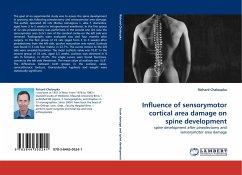In this research, the first time Manganese accumulation was observed in areas marked by reactive microgliosis neurodegeneration after cortical infarct over time. This was demonstrated in the primary lesion, but also in the ipsilateral degenerating neurons. Manganese in comparison to iron, zinc and copper, correlates spatial with the secondary neurodegeneration most striking. However, the accumulation of Mn in secondary neurodegeneration is timely delayed, starts at 7th day and riches its maximum at 17th day after infraction. Distribution of manganese in the rat brain is also analysed in this research. It is clearly seen that the Manganese distributes, after cortical infarction, in brain regions in the following order: thalamus hippocampus CSF sensoric cortex red nucleus and nucleus caudate. Whereby, the most obvious difference to literature is the higher accumulation in hippocampus and the lower accumulation in striatum (nucleus caudate). This can have the reason in the effect of cortical infarction to the afferent areas in brain.
Bitte wählen Sie Ihr Anliegen aus.
Rechnungen
Retourenschein anfordern
Bestellstatus
Storno








